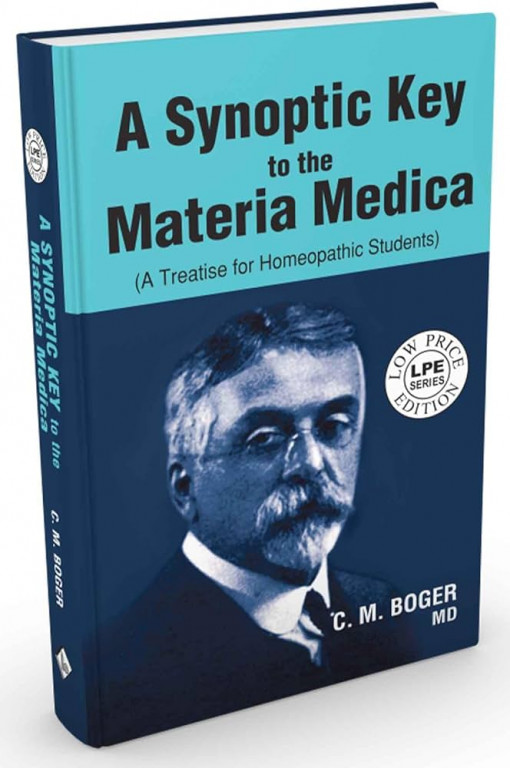- Customer Care +91 8800900271
- About Us
- Contact Us
- Sell Your Brand
- International Orders
- Disease
- Homoeopathy
- Willmar Schwabe Germany
- SBL
- REPL
- Dr. Reckeweg
- Willmar Schwabe India
- Bakson's
- Hapdco
- Lords
- Allen
- B Jain
- Adven
- Dr. Wellmans
- Indo German
- Medisynth
- Wheezal
- Adel
- HSL
- New Life
- Bioforce
- JVS
- Hahnemann Laboratory (HL) Calcutta
- Bios Laboratory (BL)
- Parul Homoeo Laboratories (PHL)
- Allen Calcutta
- Bhandari
- Dr. Bhargava
- PHBL
- SSL
- Dr Vijay's
- Natcure
- Kent Pharmaceuticals
- Similia
- Ralson
- St. George
- SHL
- Burnette's Homoeopathy
- Purusottam Homeo Bikas Laboratory (PHBL)
- Father Muller Pharmaceuicals
- National Homoeo Laboratory
- EL Dr. Lal Singh Expertise
- Dr Patel's
- Bangalore Bio-Plasgens (BBP)
- Boericke Research Laboratory (BRL)
- Ayurveda
- Unani
- Health & Fitness
- Books
- Veterinary
- Online Consultation
- International Orders


Study of Synoptic Key to Our Materia Medica by C.M Boger

- By: Dr Plakshi Ahuja
- Profession: BHMS, DNHE, MD (Scholar)
- Category: Homoeopathy
- Jan 05, 2024
Dr Cyrus Maxwell Boger, M.D. was a leading and prominent Homoeopathic Physician of U.S.A. He received his early education in the public school of Lebanon, Pa. He graduated in pharmacy and later graduated from Philadelphia college of Medicine. He studied at Hahnemann Homoeopathic Medical college, Philadelphia and qualified himself as a Homoeopath.
During his long career in medical practice and research, Dr Boger contributed a lot by his writings and successful treatment of incurable cases.
During his long career in medical practice and research, Dr Boger contributed a lot by his writings and successful treatment of incurable cases.
His vast knowledge of the homoeopathic science, his comprehension of homoeopathic philosophy and materia medica and his ability in prescribing were thoroughly exhibited and he is rightly looked upon as having attained a position in the knowledge and art of homoeopathic practice that few ever occupied.
Editions of the Synoptic Key
I edition – 1915
II edition – 1916
III edition – 1928
IV edition – 1931
Augmented edition – 1935 by Dr. Banerjee of Kolkata
ANATOMY OF THE SYNOPTIC KEY
- Foreword
- List of remedies in Materia medica portion
- Part I – Analysis
- Part II – Synopsis
- Part III – Comprises of 4 appendices
- List of remedies & their abbreviations
Foreword by Dr. C. M. Boger
The aim of the book is to simplify the use of homoeopathic materia medica so that the truly homoeopathic curative remedy may be worked out with greater ease and certainty. For this purpose the synoptic key has been presented as a combination of the analytic and synoptic method.
Subsequent to the patient detailing his/her complaints, the physician needs to elicit and ascertain:
- Cause and course of the sickness, in which All the things which now seem to interfere with the sufferer’s comfort. Especially the natural Modalities – most vital being Time, temperature, open air, posture, being alone, motion, sleep, eating and drinking, touch, pressure, discharges etc.
- Mental state, where irritability, sadness or fear is the ruling factor.
- Patient’s own description of his/her sensations, especially burning, cramping, cutting, bursting, soreness, throbbing and thirst.
- Objective aspect or expression of the sickness, including facial expression, demeanor, nervous excitability, sensibility, restlessness or torpor, state of the secretions, abnormal colouring
- Part affected must be determined, which also brings the investigation in touch with diagnosis.
the patient is allowed uninterrupted to narrate his / her complaints in as much details as possible; subsequent to which the practitioners asks questions and completes details of the patients symptoms and adds details missed out. Then the practitioner adds his/her observations to the patient’s narration to develop a complete record of the condition.
PART- I ANALYSIS
This part has a short repertory divided into the following 4 sections:
- The periods of aggravation
- Conditions of aggravations and amelioration
- Generalities i.e. consideration of drug affinities for the entire organism
- Regional repertory
The Number of medicines mentioned under the repertory section is 489
Construction of the Repertory
- Each page is arranged in Two columns
- Name of the chapter is written on the top of the page in BOLD CAPITAL
- Rubrics also represented in BOLD CAPITAL
- Sub rubrics are represented in Bold Roman Letters
- Synonyms are given soon after the rubric in Bold Roman Letters with the prefix ‘see’
- Cross references are given after the medicine in Bold Roman Letters with the prefix ‘comp.’
- Gradation of medicines
I ORDINARY CAPITALS e.g. ACON
II Bold roman e.g. Acon
III Ordinary roman e.g. Acon
- The periods of aggravation
Consists of Time Periods of Aggravations
Starts with the rubric PERIODICALLY, in general
Time periods are given in the order of
- Morning – 6 am to 12 noon
- Afternoon – 1 pm to 5 pm
- Evening – 6 pm to 8 pm
- Night – 9 pm to 5 am
Both Day timings and clock timings are given
Periodically- Daily, agg ; at same hour, agg; Weekly, agg etc
- Conditions of aggravations and amelioration
Rubrics arranged alphabetically from AIR to YAWNING
Can be taken as Causative Modalities.
Some important rubrics :
Anticipation <; Breakfast <; Dust, feathers etc <; Emotions <; Females <; Foods drinks, <; Mental exertion<; moon phase, full moon <; moon light, <; Vaccination <; Position<; Rising from sitting <; Sea, <; Seasons <; Smoke<; Sleep<; woollens<.
- Generalities i.e. consideration of drug affinities for the entire organism
It consists of the consideration of the drug affinities of the entire organism
Rubrics are arranged in alphabetical order ACHING to YELLOW.
Rubrics include locations in general like bones, joints; sensations; complaints; pathological generals; clinical rubrics; mental rubrics
- Regional repertory
Given as sub-chapters
Starts with INTELLECT & ends with SWEAT
Each subchapter is separated from others by a horizontal line
These sub-chapters are : Intellect, mind, head, external head, bones and scalp, eyes, vision, ears, hearing, nose and accessory cavities, face, teeth, gums, palate, tongue, mouth and throat, saliva, taste, appetite, aversions, thirst, cravings and desires, water brash, heart burn, qualmishness, hiccough, nausea, regurgitation, retching and gagging, vomiting, eructations, epigastrium, stomach and abdomen, external abdomen, hypochondria, flatulence, groins, anus and rectum, perineum, stool, micturition, urine, sediment, urinary organs, genitals, male organs, female organs, sexual impulse, menstruation, leucorrhoea, respiration, cough, larynx and trachea, voice and speech, external throat, neck, chest and lungs, external chest, axillae, mammae, nipples, heart, circulation and pulse; back, spine and cord (scapular region, dorsal region, lumbar region, sacrum), upper limbs, lower limbs, skin, sleep; chill, chilliness, coldness etc.; heat, sweat.
Some rubric headings given by Dr Boger have wider application e.g
- The rubric ‘Ascending agg’ includes remedies which are < by ascending in the air as in flying or ascending in a lift or ascending on the mountain or ascending up the stairs.
- The rubric ‘Abortion’ gives not only all the remedies indicated in actual abortion but also those which cover the after-effects of abortion and tendency for habitual abortion.
- The rubric ‘Forced through a narrow opening, as if’ can be apply to such varied conditions as hernia, stricture, stenosis, feeling as if food is obstructed in oesophagus, cardiospasm, proptosis etc.
- Kent has given a rubric ‘Attitude bizarre’ in Mind chapter but Boger has transferred this to the Generalities chapter so that it becomes both a mental and physical symptom.
PART- II SYNOPSIS
This part comprises of the General expression or genius of each remedy arranged alphabetically. Strain which runs through every pathogenetic complex has been called the “genius” of the drug. Its proper place in the prescription should be ideal of every prescriber.
It comprises of an exposition of the Important and Characteristic Features of the most important remedies of the Homoeopathic materia medica, with their physiological spheres of activities, modalities and relationships.
323 remedies from Abrotanum to Zinc valerianate with gradation of symptoms, using similar 3 gradations used in the repertory part.
- Construction of the Synopsis
Name of the medicine written on the top of the page in BOLD CAPITALS followed by 2 columns – Right & left
- In left column – REGION i.e., sphere of action of the remedy
- In Right column – modalities as WORSE & BETTER
This is followed by characteristic features of the remedy as a single paragraph with the most nearly affiliated remedies after some of the symptoms in brackets.
Lastly, other medicines which are Antidotes; Complementary & Related, which is not seen in every medicine are given.
PART- III APPENICES
Compromising of:
- Table of the approximate duration of action of Remedies
- Complementary remedies
- Antagonistic remedies
- Supplementary reference table
- Table of the approximate duration of action of Remedies
Number of medicines: 127 from Aconite to Zincum
Duration of action of remedies is given in weeks as superscript e.g. E.g Mag-c5, which means the minimum duration of action of Magnesium carb is 5 weeks.
Duration is given as approximate minimum duration of action of 127 remedies by weeks followed by 2 directions by Dr Boenninghausen and Dr Hering as follows:
- As long as old ailments reappear or are worse, without the appearance of essentially new symptoms which lie outside of its sphere of action, we should guard against a repetition of the remedy, or changing to a new one – Boenninghausen
- Symptoms appearing last in a proving have the highest value – Hering
- Complementary remedies
Number of medicines: 114 from Abrotanum to Zincum with their alphabetically and complementary remedies with gradations as bold roman & ordinary roman.
Gradation in the complementary relationships is a unique concept.
e.g.: ACONITE– Arn. Bell. Bry. Cof. Mill. Pho. Spo. Sul.
CALENDULA- Hep
CONIUM- Phos, Sil
- Antagonistic remedies
Number of medicines: 35 from from Acetic acid to Zincum with their antagonistic remedies (inimical relationship) which do not follow well are mentioned without any gradations
E.g. : APIS -Rhus tox
COLOCYNTH- Caust
LYCOPODIUM- Nux mos
MERCURIUS- Lach. Sil
PHOSPHORUS- Caust
SEPIA- Lach
- Supplementary Reference Table
A supplementary reference table of rubrics is given with a foreword by Dr Boger. He mentions that it has been enlarged considerably, especially by transferring most of the comparisons to it from the text of respective remedies. This makes for clearness and facility of reference.
It is the index of the repertory and materia medica part of the synoptic key.
Features:
- Rubrics arranged alphabetically, with sub rubrics.
- Many rubrics are provided with page number against them for easy reference as an index to analysis part with gradation of medicines.
- The additional sub-rubrics & medicines mentioned in this section should be used in combination with those in the analysis part.
- Clinical conditions pertaining to various parts of body are vividly described under specific part.
Some rubrics under Supplementary reference table
- ASTHMA –86. Eucal. Tab. Tub. Vis-a
bronchial – Terb; catarrhal – Calad., Caps; with coryza – Just; dry weather – Cham; of hay fever – Aru-t, Chlor; from hives – Apis; humid – Cann.
- BACK – 94
acne – Rumex; cyst on – Phos; mental exertion – Pic-ac; stiffness ascends – Ars.
- BONES–31. 97. 98. Phyt. Pyro. Syph.
exostoses – 31 Sulph iod, Syph;
weather changes agg. –20 Am-c.
- BURNS –32 Urt-u.
- CALCULI –32 Coc – c.
- DUODENUM – Pod, Uran-n.
- X-RAY BURNS – Calc fl.
LIST OF REMEDIES AND THEIR ABBREVIATIONS
Number of medicines: 489 medicines from Abies canadensis to Zizia aurea with their abbreviations used in repertory.
SCOPE OF THE SYNOPTIC KEY
- Simplified practical application of combining philosophy of Dr Boenningausen with that of Dr Kent
- Synopsis of medicines i.e. the whole sphere of action of drugs is presented in a nut shell.
- Modalities are given which are helpful for prescription. Time and conditions of aggravation and amelioration is a highly useful.
- Sphere of action of drug are given which will help physician to study or classify the drugs in a group which in turn will help clinician in quick prescribing.
- Complementary and related medicine given at the end that will help physician in second prescription
- Concept of Materia Medica & repertory together, helps for easy reference
- Gradation of symptoms in synopsis is very valuable
- It is a quick bed side reference
- Part III, supplementary reference tables are the highlights of this book
LIMITATIONS
- Limited number of medicines
- Number of the related medicine is less
- Limited number of rubrics
- Less Number of nosodes
- Cannot be used for systemic repertorisation
HOW TO REFER TO THE REPERTORY
The rubric which needs to be referred, should be looked into the related section of analysis and also in supplementary reference table. The combined rubric should be used for all the practical purpose. For searching any symptom/rubric one should refer’ supplementary reference table’ first which works like as index.
BUY THE BOOK HERE:
https://www.emedicinehub.com/p/d/a-synoptic-key-of-the-materia-medica-by-cm-boger
Get the Latest Updates Blog
 Click here to Pay
Click here to Pay

Please send the screenshot at 880 090 0271

